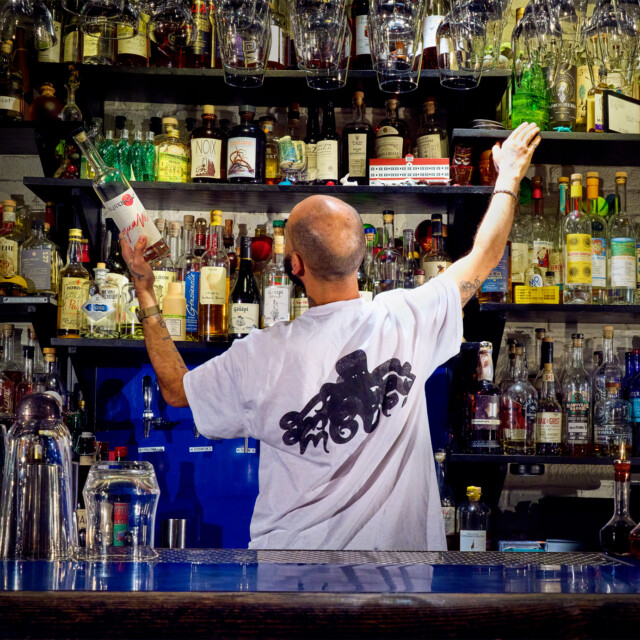The day I graduated from college I was fortunate enough to already be working my dream job, bartending at New York’s Booker and Dax. We were a tight team, and it was a place I felt completely accepted and at home. Naturally, it was the only choice for a celebratory drink after the ceremony, so once the cap and gown were hung up, I ponied up to the bar.
The brilliant Maura McGuigan was general manager at the time. Maura is the kind of person who will teach you something every second of every minute spent in her company, and although I had just finished school, she tricked me into learning one more important lesson. It began with a question, and one of those sentences that should be surrounded by a trumpeting choir of angels: “Hey Jack, want some Pappy?” she asked. “Your choice which one!”
Keep in mind, in 2014 you didn’t have to sign a blood oath with your Southern rep and stash 14 cases of Fireball in a basement to get a Pappy allocation. We received one bottle of everything that year: Lot B 12-year, 14-year Rye, plus the big dogs, Pappy 15, 20, and 23. I made what I felt was the obvious choice and asked for a dram of the 23. Maura smiled knowingly as if to say “OK, if you insist!” and poured a healthy two fingers.
Trembling with anticipation I brought the glass to my lips. The choir of angels stopped. I stared at the glass, then looked up at Maura who had the widest grin on her face. “This kind of just tastes like oak,” I said, stunned. “I know,” she replied. Maura tricked me into an incredibly valuable (literally money-saving) lesson: Just because a bottle is the most expensive or most sought after doesn’t mean it’s the most delicious or the right spirit for the occasion or a particular cocktail. Her parting words that night: “It’s OK Jack, the next time you graduate you can try the 15 or the rye.”
That lesson rewired my brain and colored the way I think about spirits and backbars to this day. The pissing contest of who can have the most bottles or the craziest allocation isn’t alluring. All it takes is the right budget to build one of those bars. The real skill lies in considered curation, especially in a tight space.
There are countless phenomenal bottles from around the world (and probably from right around the corner as well) and the choices made by a spirit buyer should tell a story — it’s why bars like Amor Y Amargo with its long list of bitters, Maison Premiere’s careful selection of brandy, absinthe, and rhum, and Mirate’s overwhelming adoration of agave are so compelling.
From Backbar to Cocktail
Beyond the spirits list handed to guests, backbar choices become the palette of flavors from which bartenders create drinks. There’s a reason so many establishments have that aura of sameness to their bar programs and it starts on the backbar. There is certainly nothing wrong with a bar or restaurant that has a little bit of everything and a well-thought-out list of classic cocktails, but for the spaces that go for that next level of creativity, a well-selected backbar is essential to keep cocktails interesting and economical.
So how does one build a purpose-driven backbar? And once the bottles are in-house, how does one turn them into drinks that allow their contents to shine?
There is one bar, and one bartender I look to for inspired drinks and bold bottle choices.
Building a Backbar
In 2019, Orlando Franklin McCray was brought on to run the bar program at Nightmoves, the part-dance club, part-cocktail bar that shares a wall and ownership with one of the best wine restaurants — frankly, best restaurants period — in Brooklyn, The Four Horsemen. Prior consultants had already built out a little program: 20-bottle backbar, short list of serviceable classics — essentially, the age-old formula on display at bars around the country.
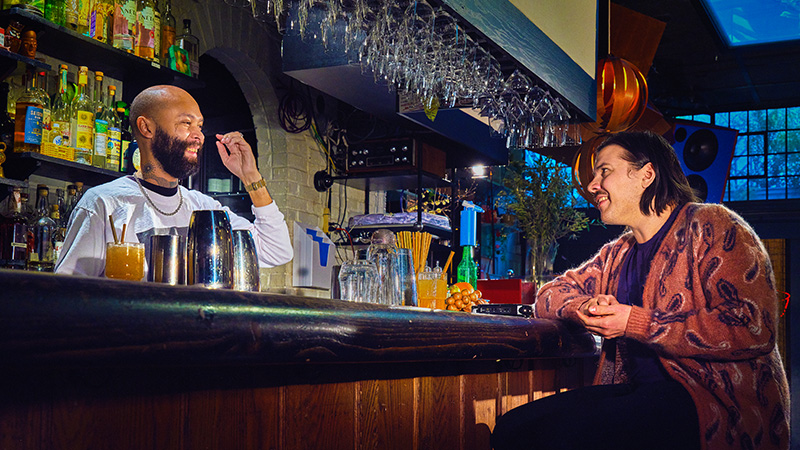
They asked Orlando what he thought of it and his response changed the shape of the program in an instant. “Basically, I think this is trash,” he told them. “What you’re doing with wine next door, I want to do with spirits here.” That sea change, the seemingly obvious choice to align the ethos across the two spaces led to the formation of what I consider to be the most interesting backbar in New York.
“Put something new in front of somebody without being a snob about it.”
Orlando filled the little space he had to the gills with spirits and liqueurs that showcase terroir; mezcal, r(h)um, brandy, and an extensive shelf dedicated to eaux de vie. There are precious few whiskeys save for a handful from Scotland and Japan, and a hefty contingent of amaro and fruit liqueurs, as well as more than a few bottles from New York State distillers and producers.
The most striking aspect to this former spirit buyer: Not a single bottle on display comes from the big conglomerates — Diageo, Pernod-Ricard, Gruppo Campari, Bacardi, and the like. It’s a bold statement, and one that Orlando knows could lead to a lot of puzzled first-time guests.
“I think sometimes people see this and it’s intimidating and I don’t want that,” he tells me.
Conversations with guests usually unfold along the lines of “I don’t have this product, but if that’s the category that you’re interested in, I have this other thing, and it’s priced the same.” Orlando explains that the goal of every service is to “put something new in front of somebody without being a snob about it.” Indeed, on the night the bar opened, his partner Taylor Adorno slipped him a handwritten note that brilliantly encapsulates what he’s trying to accomplish: “Nothing to prove, everything to share.”
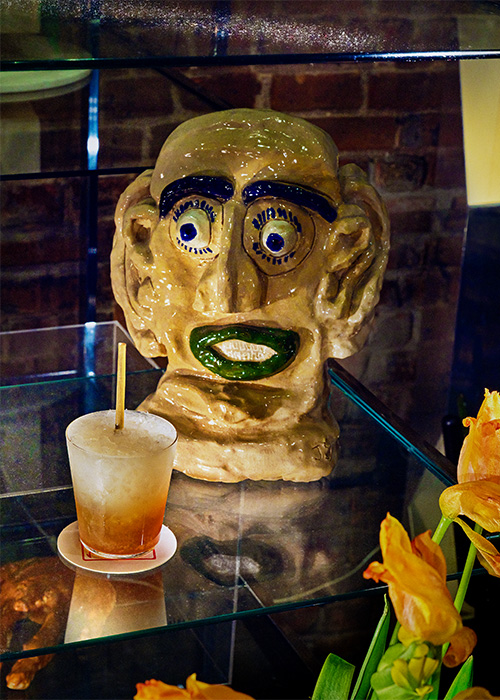
Our present-day conversation moves from ethos to individual bottle selections and why he showcases these specific categories. Ultimately, it comes down to whose work Orlando wants to celebrate.
“If you have the best possible agricultural product, if you have the best fruit, the best vegetable, whatever it is, and you distill that well,” he explains, “then it’s communicating exactly the amount of effort that was put into the production of this thing.” The farmer who grew the crop and the distiller who transformed it can tell an entire story with the liquid in a bottle.
While production is smaller on the expressions that Nightmoves stocks, the price is comparable to products from well-known brands because there’s usually no marketing department to pay. Orlando does the work of cultivating relationships with producers and the small distributors they work with, then passes that knowledge along to his guests. I asked him if this buying strategy meant that he could focus on brands that are thoughtful ecologically and in the way they treat employees, and he was quick with his retort: “I think that everybody who buys liquor is able to do that.”
Showcasing a Product in a Cocktail
Nightmoves is unique in that the space itself could not be further from what comes to mind when you imagine a venue that offers incredible cocktails. It doesn’t have a single barstool. It does have lounge-y, comfy couches tucked in corners, a spectacular McIntosh stereo, vinyl-only DJ booth, and light-up dance floor. It exists in a class of its own as a cocktail nightclub.
As a result, drinks need to come out of the bar fast so that guests can get back to dancing. Fortunately, Orlando’s style of drinks are built for speed. “You take the fewest number of things that taste good together,” he says. “That’s your drink.”
When it comes to making cocktails like Orlando, it’s a much different mindset than most bartenders are used to. Classic ratios and cocktail specs are much less important than just tasting something until it’s right.
He illustrated the point with a new cocktail he had just finalized, his take on an Amaretto Sour. Every cocktail bartender I know has at least a few specs for this oft-maligned classic. The most common approach is the Jeffrey Morgenthaler recipe that splits the amaretto with overproof bourbon for backbone. I’ve heard of bars adding Campari, orange juice, amaro — anything to cover up the cloying sweetness.
Orlando’s Amaretto Sour has only three total ingredients: Walcher Amaretto (a small producer from Alto Adige, an Italian region that shares a border with Austria), lemon juice, and dilution. He batches it in a corny keg and charges it with just enough CO2 so it comes out “fuzzy,” or barely effervescent. It’s a 10-second pickup to pour over ice, and it was the most delicious Amaretto Sour I’ve ever tasted. He selected a beautiful and compelling liqueur and added the fewest possible ingredients to make it shine.
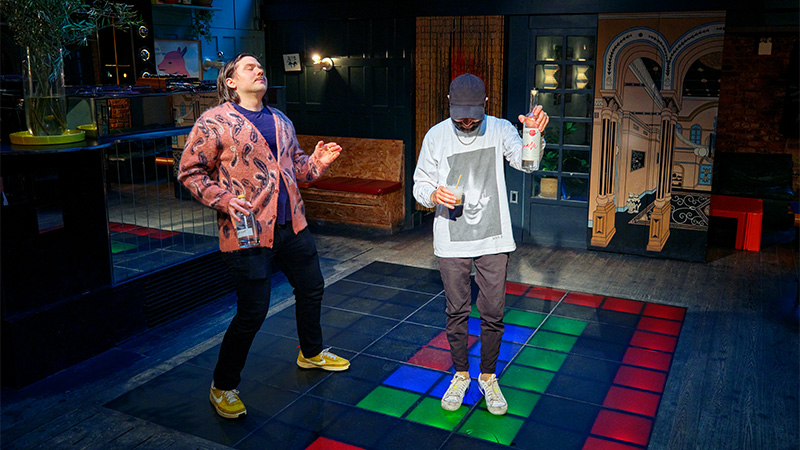
While I’m still shook from processing the excellence of the sour, Orlando poured another cocktail. The Demon Time also combines just three ingredients: Larusée Absinthe Bleue, Fever Tree Cola, and lime juice, this time layered over crushed ice. It tastes exactly like a turbocharged Haribo Fizzy Cola, which is exactly what he intended. Tapping into nostalgia while maintaining simplicity, Orlando takes the best spirits he can find and makes them “taste like being a kid.” It’s an ingenious methodology and why I love Orlando’s drinks. I spent years tinkering with a quarter- ounce of this and a bar spoon of that, trying to evoke a memory, and Orlando solved it in a snap.
Buy Bottles, Make Candy
Whether you’re running a bar program or buying spirits for home, Nightmoves’ methods are easy enough to replicate; it just requires some time and dedication. Ask about the products you’re buying, Orlando advises, and take the time to research bottles before they make it onto your shelf. If the information you can find is murky at best or full of marketing buzzwords, maybe consider another bottle. Look locally first and discover who is making delicious products in your area, then scour the globe. It may sound simple, but it requires a commitment to constantly learning, tasting, and building community.
When it comes to making cocktails like Orlando, it’s a much different mindset than most bartenders are used to. Classic ratios and cocktail specs are much less important than just tasting something until it’s right. To test it, I took a bottle I’m absolutely loving right now: the Song Cai Distillery May amaro.
Song Cai is dedicated to uplifting rural communities in Vietnam by supporting farmers and foragers and providing them with incentives to preserve botanicals and local heirloom grains. The amaro just got approved for distribution in the states and it’s a stunner. Bold, bitter, and dry, with cinnamon, pine, and poppy notes. I added just enough simple syrup, lime juice, and soda to bring back memories of childhood Christmas mornings eating homemade cinnamon rolls and drinking the glass-bottle Coke with the drawing of Santa on the side. If you come across a bottle of May, give this one a try. Otherwise, find a bottle you love and give it the same treatment.
Mayday Recipe
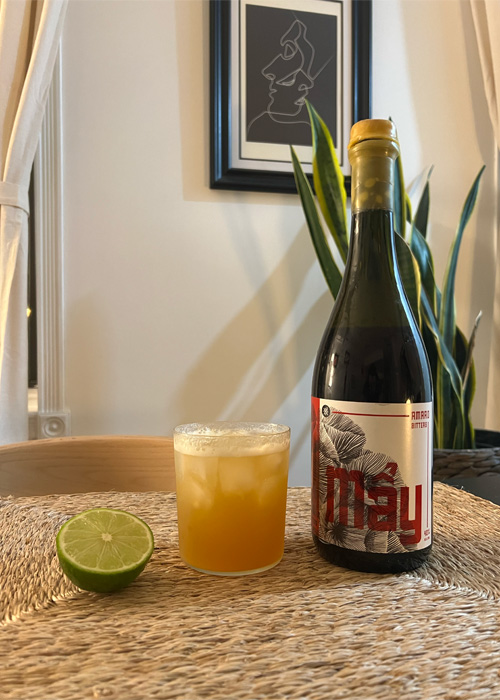
Ingredients
- 1 ½ ounces Song Cai May amaro
- ½ ounce lime juice
- ½ ounce simple syrup
- 4 ounces club soda
Directions
- Combine all ingredients in an ice filled highball or rocks glass.
- Stir to combine and enjoy.
This story is a part of VP Pro, our free platform and newsletter for drinks industry professionals, covering wine, beer, liquor, and beyond. Sign up for VP Pro now!
